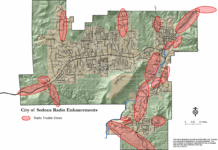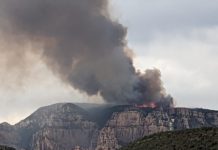
The Coconino National Forest stated Wednesday, Sept. 27, that after Tuesday’s successful management of the now-800-acre Cecil Fire, fire crews would continue firing operations Wednesday, but do not plan to conduct firing operations past Thursday morning, Sept. 28, due to a forecast increase in wind speeds.
Fire managers said the Cecil Fire is planned to grow to 2,100 acres by the end of this week’s management actions. Crews will spend the weekend securing lines around the fire’s perimeter.
The Cecil Fire, and the Still Fire in the Mogollon Rim Ranger District east of Sedona and southeast of Happy Jack, are both lightning-caused wildfires being managed to reduce hazardous fuels and improve forest health as guided by the U.S. Forest Service’s 10-year Wildfire Crisis Strategy.
pio_8x11_land_20230926_1944_Cecil_AZCOF001069_0927Due to the accumulated fuels in the fire areas, both wildfires will generate significant smoke during planned firing operations. The Cecil Fire was first reported Sept. 18 and is burning ponderosa and pinon pine.
Smoke will remain highly visible from the Sedona areas as well as along State Route 89A. Smoke will settle into the Oak Creek Canyon area during the evening. Close your windows at night and, if you have respiratory problems, avoid outdoor activities especially in the morning when low-level smoke is at its worst.
Those managing the Cecil Fire include two Hotshot crews, two engines, one engine crew, one hand crew, a water tender and miscellaneous overhead drone aircraft. More resources have been ordered to the fire to help with planned operations.
“We recognize smoke can be impactful and inconvenient for area residents and visitors,” the Coconino National Forest stated. “Managing these fires and reducing the hazardous fuels in these areas of the forest under the current weather conditions will temporarily produce heavy smoke impacts, but it will also reduce the amount of fuel on the ground and help protect communities from high-intensity wildfires. If a future wildfire starts in this area, it will be more manageable and it will result in fewer overall smoke impacts to the communities.
“The Coconino NF is a fire-adapted ecosystem, which needs incremental fire to maintain forest resiliency.”
For current information on smoke, visit the Fire and Smoke Map via airnow.gov.


















